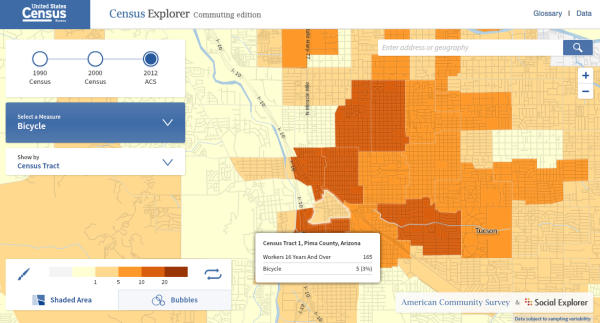 While the number of Tucson bike commuters has stagnated at about 2 percent of the population, new data shows some areas of Tucson see almost 20 percent of the residents commuting by bike.
While the number of Tucson bike commuters has stagnated at about 2 percent of the population, new data shows some areas of Tucson see almost 20 percent of the residents commuting by bike.
Census data released last week shows there are 11 Tucson census tracts in which five percent or more of the people who live in the tract bike to work.
Another seven show that more than 10 percent of the people living in the census tract bike to work.
One area, census tract four, which is bounded roughly by Mabel Street on the north, First Avenue on the east, Toole Avenue on the south and Stone Avenue on west, showed 19.7 percent of its residents biking to work.
The data comes from the American Community Survey, which asks participants about their commuting habits. Interestingly, the question about your commute mode asks for the most frequent way you get to work. If you drove in a car three days a week and rode a bike twice, you would be counted as a driver.
Here’s what the census department says about census tracts:
Census Tracts are small, relatively permanent statistical subdivisions of a county or equivalent entity that are updated by local participants prior to each decennial census as part of the Census Bureau’s Participant Statistical Areas Program. The Census Bureau delineates census tracts in situations where no local participant existed or where state, local, or tribal governments declined to participate. The primary purpose of census tracts is to provide a stable set of geographic units for the presentation of statistical data.
Census tracts generally have a population size between 1,200 and 8,000 people, with an optimum size of 4,000 people. A census tract usually covers a contiguous area; however, the spatial size of census tracts varies widely depending on the density of settlement. Census tract boundaries are delineated with the intention of being maintained over a long time so that statistical comparisons can be made from census to census. Census tracts occasionally are split due to population growth or merged as a result of substantial population decline.
Census tract boundaries generally follow visible and identifiable features. They may follow nonvisible legal boundaries, such as minor civil division (MCD) or incorporated place boundaries in some states and situations, to allow for census-tract-to-governmental-unit relationships where the governmental boundaries tend to remain unchanged between censuses. State and county boundaries always are census tract boundaries in the standard census geographic hierarchy. Tribal census tracts are a unique geographic entity defined within federally recognized American Indian reservations and off-reservation trust lands and can cross state and county boundaries.
The map also shows the other modes in which people used to get to work, average commute times and more. Check out the map to explore for yourself.
Here’s some of the other interesting tidbits.
- Only two tracts showed more than 10 percent public transportation usage.
- More people appear to walk to work than ride bikes and 45% of the people who live around the UA walk to work.
- The average commute to work is 24 minutes for Pima County residents.

Census tract 4 is smack dab in the middle of the St Car line. It’s bisected by the rails in 2 directions. Why would you add a short (3.9 mile) rail interface in the middle of a statistically prime cycling area? 1 in 5 is a huge number. I would think that this is a success that the city would want to nurture not harass. Census tract 4 has a healthy functioning street grid. It was developed early on and there are no large areas that are impassable to vehicles like there are further north. It’s also almost all contained within an area where there is connectivity to commerce without having to cross major arterials like Speedway or Broadway. This census data is a big deal and it supports what the residents of this area have been saying for the past 5 years. We’re living your dream, don’t screw it up with relaxed development standards and incentives that encourage short term exploitation of the scarce available developable land.